The content of the article
A distinctive characteristic of the olive runner is the speed of movement. This variety of reptiles is quite active and at the same time aggressive. While approaching, the snake does not emit a hiss, it very quietly creeps up and attacks. The danger coming from the snake is not too high. On the surface of the snake appear in early spring, they are active when the sun does not fry too much. Let's look at everything that is characteristic of these individuals.
Description
- According to its external features, this representative of the family can not be called bulky. The maximum recorded length is 1 meter. But, as a rule, individuals with a length of 85 cm are found on average. Males are thinner and more beautiful than females. Last compacted and shorter.
- The head is rounded in front. The shield between the jaws is poorly visible and slightly wedged between the sinuses. The shields at the back are detached, creating a small scale pattern. Their characteristic difference from the shields in the front is an elongated format.
- About 230 small scutes are focused in the marginal parts; they are located along the rib sections and form a small canticle in the abdominal region. Scutellum anal paired, papillomaris consists of 130 particles.
- As for the general color of the case, in the upper part of the snake is pigmented olive-gray with brownish or brownish blotches. The neck and front section of the body are dark green; these spots have a fringing that turns black. Yellowish rings are also present.
- In the neck area, a color shift may be observed. The marks are intertwined with each other, forming a single whole and moving away by dimensional features. The head in the upper section has no patterns, but some individuals have specks. The abdominal part is yellowish, of one tone, may be whitish or yellow-green. The irises are yellow with a golden tint.
Habitat
- These representatives of the breed group are not classified as rare species. To a greater extent, they are common on the Balkan Peninsula. There are individuals in Asia Minor, Ingushetia, Chechnya, Abkhazia, and Azerbaijan. There is a population of individuals in Turkmenistan, but their number has not been studied.
- Reptiles of this type prefer stony, semi-desert terrain. They can be found in steppe strips, as well as on slopes with small pebbles and in mountainous terrain. Juniper and oak attract them, so they find family members in their respective areas. Some individuals are found in areas located at an altitude of 2.2 km. from sea level. Snakes are in the gardens, often scare gardeners with their appearance.
- An interesting fact remains that the considered individuals remain one of the most rapid reptiles that live on the territory of the Russian Federation. When such snakes move in natural conditions, you physically cannot follow them.
- Snakes move very quickly and at the same time smoothly. They glide among plants and stones. Individuals simply dissolve in the eyes when moving. It is impossible to keep track of them. Interestingly, such reptiles have excellent vision.
- It is thanks to such a natural feature that they seek out and look for prey. Before the hunt, the snake begins to explore the area. Sometimes an individual rises to look around. The snake bends to raise the front of the body.
- As soon as the presented individual notices a potential victim, the snake silently and swiftly creeps to the target. When there is a small distance, the snake immediately strikes its prey. Due to its speed, the snake catches up even with a running victim.
- The diet of such reptiles is based mainly on lizards. If the victims are small, the snake immediately swallows them whole. As for larger goals, the snake kills them or strangles them. In addition, such individuals feed on grasshoppers.
Breeding
- During the mating season and at the time of mating, the male grabs the female with his jaws and does his job. It is worth noting that the females of this species do not have high fecundity.
- In most cases, such snakes bring no more than 5 very elongated eggs. As for young animals, they are born of a rather large size. In length, they reach up to 30 cm.
Often considered individuals are kept in captivity. They are slightly picky, if you follow some rules. Get a horizontal terrarium of at least 100 liters. Coconut chips are best used as a substrate. There should also be snags and a house. Do not forget about lighting and heating.
Video: olive snake (Platyceps najadum)

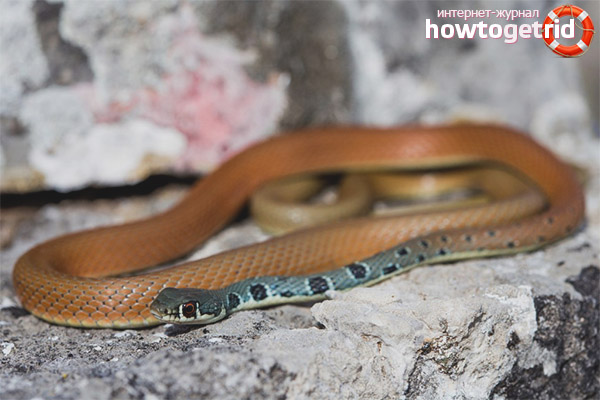

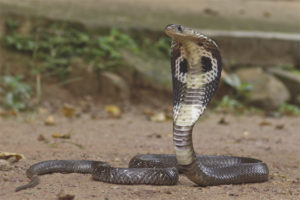
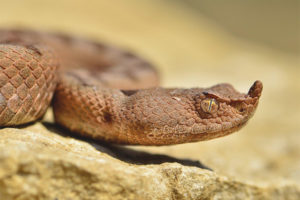
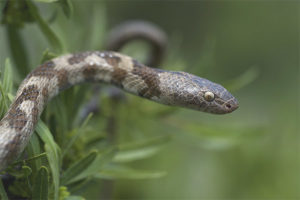
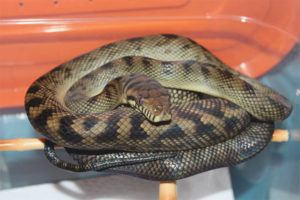
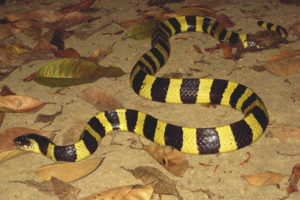

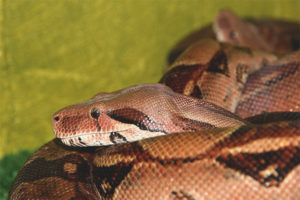
Submit